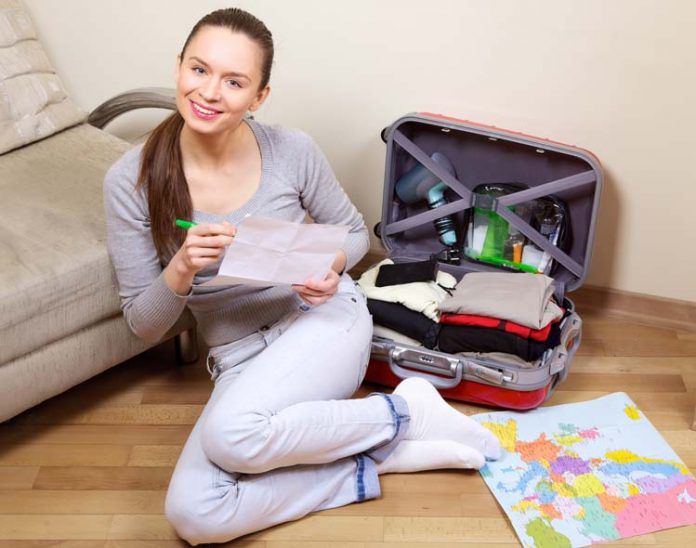Planning a trip to Europe? This relatively small continent is very diverse, both geographically and culturally, so you need to be smart when preparing your luggage. Sizzling Spain, rainy Ireland, windy Norway, the weather in Europe changes depending on the location. As if it wasn’t enough, seasons vary significantly. Countries in central Europe have hot summers, but freezing winters. Scandinavia is usually cool, but during the short summer, it can get hot. You need to get ready for a meeting with the moody, changeable European climate. You should also be aware of the cultural rules of the places you’re going to visit. How to keep all of this in mind and pack the most suitable travel clothes for Europe? Here’s a list of tips to make it easier for you.
-
Table of Contents
Travel clothes are always lightweight
First of all, don’t take too many things. Whether you’re going for a business trip or a backpacking journey, it’s always better to travel light. Sooner or later, you’ll have to carry your luggage, and the last thing you want is to wander around with a terribly heavy suitcase. If you like to be fancy and style plays an important role for you, remember one thing: when you travel, you move from one place to another always. Few people will see you twice, so you don’t have to worry about wearing the same clothes all the time. Pack only the things you need the most.
-
Take multifunctional pieces of clothing
Some travel clothes can change their form depending on what you want them to be. A simple white shirt, let’s say, can look incredibly chic if you add a tie and wear elegant trousers, but if you pair it with jeans, it’s going to be fresh and casual. A long summer dress will be perfect for the beach, but in case you’re going out for dinner to a nice restaurant, even a bit of simple jewelry and makeup will make it look stylish. Extravagant, different travel clothes are great, but they don’t come in very handy when traveling. Try to choose the things you can use in various places and occasions.
-
Be classy
Most of Europeans are quite fashion conscious, and they pay attention to their appearance – whether we consider it beautiful or not, it’s true. You’ll see few people walking in gym shoes around the cities or combining sandals with socks, no matter how comfortable it might be. If you don’t want to scream “I’m a tourist” and attract surprised looks, try to be classy. It’s especially important for those who’re planning to dine in fancy restaurants, visit opera houses, etc. These kinds of places have a particular dress code, and the typical touristy clothing won’t be gladly approved.
-
Keep it comfy
Being comfortable is the most important. It means various things for various people – some feel the best in more official travel clothes, others love jeans and sneakers. Think of what you’re going to do, because that’s crucial. For city breaks, casual travel clothes and comfortable shoes will be perfect. If you want to explore national parks, hike and spend a lot of time in nature, you’ll surely need good trekking shoes. In Scandinavia, United Kingdom, and Ireland, a waterproof jacket is a must. In the South of Europe you won’t need warm clothes, but something light and practical. Adjust the luggage to your travel plans. Remember it’s crucial to feel comfortable when you’re moving. A pair of terrible shows or a dress that is so tight you can barely walk in it – this kind of things can ruin your days. Instead of enjoying new places and beautiful views, you’ll just feel irritated. Travel clothes for Europe, just like any outfits for travelers, should be most of all practical.
-
Respect the culture
Some places across Europe have strict rules concerning the clothing. There aren’t many of them, but it’s good to keep it in mind. When visiting religious sites, you should wear travel clothes that cover most of the body. The rules vary depending on religion, but in most places you should avoid shorts and keep your arms covered. In some, like the Orthodox churches, it’s expected from women to cover their heads (although in most of such sites at the entrance you’ll find baskets with headscarves, so you don’t have to worry too much about it).
-
Blend in
It’s better to look like one of the locals than announce to the whole world you’re a tourist. First of all, you’ll probably receive friendlier service in many places if you seem like you’re a part of the community. The second reason is even more important – pickpockets love tourists. They can easily recognize who’s a guest in the town. Flip-flops, little backpacks, sports shorts, t-shirts with Eiffel Tower, Big Ben or “I love Spain” prints – this kind of things call out to the sneaky pickpockets.
-
Don’t be too flashy
Even if you’re going to visit posh places and most of your luggage must be filled with elegant travel clothes, take something informal as well. During walks around the cities, it’s better to look rather casual. Avoid being ostentatious. The reason is very simple, just like in the point above shiny jewelry, expensive suits, and bags with great labels, these are the things pickpockets notice immediately. Most of the places around the continent are fairly safe, but it’s better to be careful than regret later, so when choosing travel clothes for Europe, take something unpretentious.
These tips will help you to stay safe and feel comfortable, but remember you don’t need to get rid of your personal style just because you’re traveling. Take your favorite stuff, pack some little things that make you feel unique, be reasonable when traveling to culturally specific places or those with harsh weather and… enjoy the journey!




